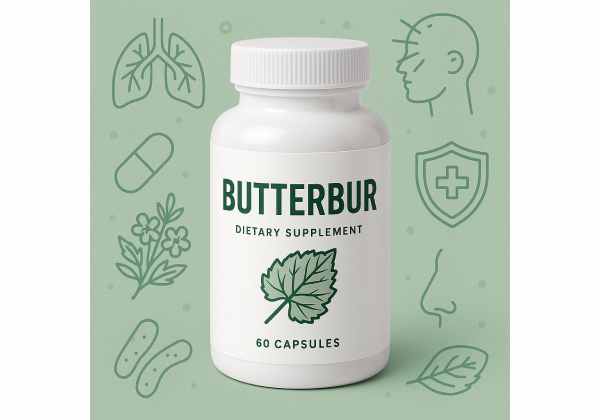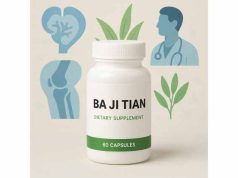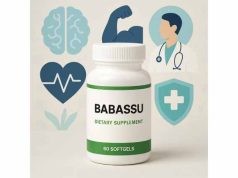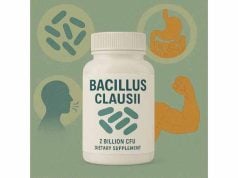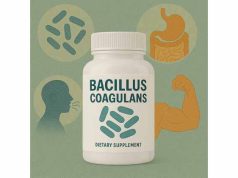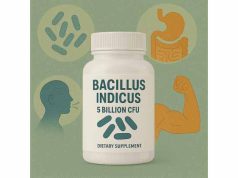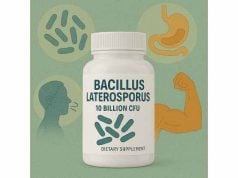Butterbur, known botanically as Petasites hybridus, is a perennial herb with a long legacy in traditional European and Asian medicine. Most commonly used for migraine prevention and allergy relief, butterbur has gained modern acclaim as a natural alternative for those seeking relief from headaches, hay fever, and even asthma. Its unique compounds—petasins—offer anti-inflammatory and antispasmodic effects that set it apart from other herbal remedies. However, not all butterbur supplements are created equal: knowing which preparations are safe and effective is essential for optimal results and peace of mind.
Key Takeaways
- Natural Migraine and Allergy Support: Butterbur is best known for reducing migraine frequency and severity, as well as easing seasonal allergy symptoms.
- Choose PA-Free Extracts: Only use butterbur supplements that are certified pyrrolizidine alkaloid (PA)-free to avoid liver toxicity.
- Backed by Science: Several clinical trials support its use for migraines and hay fever, making it a well-researched herbal remedy.
- Mild Side Effects: Generally well-tolerated, but may cause mild digestive upset in some people.
- Consult Your Healthcare Provider: Especially important for those with liver issues or who are pregnant, nursing, or on multiple medications.
Table of Contents
- Butterbur Plant History and Core Wellness Roles
- Butterbur Unique Active Compounds and How It Works in the Body
- Evidence-Based Health Benefits and Uses of Butterbur
- Butterbur Supplement Safety, Risks, Tolerability, and Interactions
- Dosage Guidelines, Forms, and Best Practices for Butterbur Use
- Butterbur Frequently Asked Questions (FAQ)
Butterbur Plant History and Core Wellness Roles
Butterbur is a large-leaved perennial herb that thrives along riverbanks and damp fields throughout Europe, parts of Asia, and North America. The plant’s impressive leaves—sometimes over two feet wide—once provided shelter for travelers, inspiring its common name. But butterbur’s reputation goes far beyond folklore; for centuries, its rhizomes and leaves have been central to herbal medicine traditions for a range of ailments.
Botanical Profile
- Scientific name: Petasites hybridus (with related species Petasites japonicus, Petasites officinalis, and others)
- Plant family: Asteraceae (daisy family)
- Key identifying features: Huge, heart-shaped leaves, purple-pink flower spikes that bloom before the leaves emerge
- Parts used: Primarily rhizome/root, sometimes leaves (never flowers, due to high alkaloid content)
Traditional and Historical Uses
Butterbur’s role in healing goes back at least to ancient Greece, where it was prescribed for pain, fever, wounds, and respiratory complaints. In Europe and Japan, butterbur tea or tinctures became household remedies for:
- Headaches and migraines
- Seasonal allergies and hay fever
- Asthma, cough, and bronchitis
- Digestive disturbances and stomach cramps
- Skin wounds and swelling (topical use)
Butterbur was especially prized for soothing spasms, easing congestion, and calming pain—effects now supported by modern pharmacology.
Modern Therapeutic Focus
Today, butterbur’s primary acclaim comes from its:
- Migraine-preventive effects: Proven in multiple clinical trials, often compared to prescription medications.
- Anti-allergy action: Comparable to antihistamines for reducing sneezing, congestion, and itchy eyes.
- Bronchodilator and anti-inflammatory properties: Offer hope for those with mild asthma and chronic cough.
How Butterbur Is Prepared
- Extracts: Highly purified, PA-free extracts are standard in modern supplements.
- Tinctures/teas: Rare today, as unpurified butterbur can contain toxic alkaloids.
- Capsules/tablets: The most popular and safest commercial form.
Related Plants and Confusion
Butterbur is sometimes confused with coltsfoot (Tussilago farfara), a related but different medicinal herb. Only butterbur standardized extracts are recommended for supplementation.
Summary
From medieval healing to modern clinical studies, butterbur has long been trusted for its ability to relieve pain, congestion, and allergic symptoms. The modern emphasis on safe, purified extracts ensures the tradition continues with a strong safety foundation.
Butterbur Unique Active Compounds and How It Works in the Body
The benefits of butterbur stem from its unique blend of phytochemicals—primarily petasin, isopetasin, and neopetasin—concentrated in its rhizomes. These compounds drive its anti-inflammatory, antispasmodic, and antihistamine effects. However, safety hinges on removing toxic pyrrolizidine alkaloids (PAs), which can damage the liver if consumed over time.
Key Active Compounds
- Petasin: The star ingredient responsible for relaxing smooth muscle and blocking inflammation.
- Isopetasin & neopetasin: Enhance petasin’s effects, further reducing spasms and allergy symptoms.
- Other terpenes & flavonoids: Add antioxidant and immune-modulating benefits.
- Pyrrolizidine alkaloids (PAs): Toxic compounds present in unpurified butterbur; must be removed for safety.
How Butterbur Works
1. Anti-Inflammatory Action
- Blocks leukotriene and prostaglandin synthesis: These molecules trigger inflammation, pain, and allergic reactions. By suppressing them, butterbur helps prevent migraines and allergies at their source.
2. Antispasmodic Effects
- Relaxes smooth muscle: Petasin and isopetasin calm spasms in blood vessels (helpful in migraines) and airways (beneficial in asthma and allergies).
3. Natural Antihistamine
- Inhibits histamine release: Similar to pharmaceutical antihistamines, butterbur may reduce symptoms like sneezing, itching, and runny nose in allergy sufferers.
4. Blood Vessel Support
- Reduces blood vessel swelling: Key for migraine prevention, as dilated or inflamed blood vessels can trigger attacks.
Safety Mechanism: PA Removal
- Why PA-free matters: Modern butterbur supplements must be certified “PA-free.” Consuming PAs over time can cause veno-occlusive disease, liver damage, or even cancer. Never use wild, unpurified, or homemade butterbur products.
Absorption and Bioavailability
- Standardized extracts: Provide consistent dosing of petasin and isopetasin, optimizing benefits and minimizing risks.
- Best with food: Increases absorption and reduces risk of digestive upset.
Summary
Butterbur’s effects are driven by petasin and related compounds that reduce inflammation, relax spasms, and block allergy triggers. Modern extraction techniques ensure these benefits can be enjoyed safely, without the dangers of toxic alkaloids.
Evidence-Based Health Benefits and Uses of Butterbur
Butterbur has earned its place as a science-backed natural therapy—especially for migraines and allergic rhinitis. While traditional uses span everything from pain to asthma, modern research focuses on a few well-studied applications.
1. Migraine Prevention
- Clinical research: Several double-blind studies show that standardized, PA-free butterbur extract (50–75 mg twice daily) can reduce the frequency, severity, and duration of migraine attacks.
- How it works: By reducing inflammation and relaxing blood vessels, butterbur helps prevent the chain reaction that leads to migraines.
- Comparable to medication: Some studies suggest effects similar to prescription migraine preventives, but with fewer side effects.
2. Seasonal Allergy Relief (Allergic Rhinitis/Hay Fever)
- Natural antihistamine: Butterbur extract can be as effective as conventional antihistamines (like cetirizine or fexofenadine) for relieving sneezing, nasal congestion, and itchy eyes—without drowsiness.
- Best for: Individuals who want a non-sedating, plant-based option for allergy season.
3. Asthma and Respiratory Health
- Traditional remedy: Used for centuries to ease asthma, bronchitis, and persistent cough.
- Modern evidence: Early studies indicate that butterbur may help reduce bronchial spasms and inflammation, improving breathing comfort for some people with mild asthma.
4. Additional Traditional and Supportive Uses
- Digestive relief: Butterbur tea or extract has been used to ease stomach cramps and digestive upset.
- Menstrual pain: The herb’s antispasmodic effects may help with menstrual discomfort, though research is limited.
- Topical use: Traditional poultices applied to wounds or inflamed skin.
5. Who Can Benefit Most?
- Migraine sufferers seeking natural alternatives
- Individuals with seasonal allergies or mild asthma
- Those seeking a non-sedating, plant-based anti-inflammatory
Realistic Expectations and Limitations
- Not for acute migraine treatment: Butterbur is for prevention, not relief of active attacks.
- Gradual effects: Results may take 2–4 weeks of regular use.
- Not a cure: Best used as part of a comprehensive management plan.
Summary
Butterbur’s reputation is well-deserved, particularly for preventing migraines and easing allergies. Its unique anti-inflammatory and antispasmodic actions offer plant-powered relief, as long as high-quality, PA-free extracts are used.
Butterbur Supplement Safety, Risks, Tolerability, and Interactions
Butterbur stands out as an effective natural remedy—but only when used in its modern, purified, and PA-free form. While generally well tolerated, there are critical safety considerations, potential side effects, and interactions users must know before starting a supplement routine.
1. Pyrrolizidine Alkaloids (PAs): The Critical Safety Issue
- PAs are toxic compounds naturally found in all raw butterbur plants.
- Dangers of PAs: Long-term exposure can cause severe liver damage, veno-occlusive disease (a type of liver blood vessel blockage), and may be carcinogenic.
- Safe supplements: Always choose products certified “PA-free” by reputable third-party testing. This ensures all toxic alkaloids have been removed through advanced extraction processes.
- Never use wild, raw, or home-prepared butterbur: Only commercially produced, PA-free extracts are safe for human consumption.
2. General Tolerability
- Most users experience little or no side effects when taking recommended doses of PA-free butterbur extract.
- Mild digestive upset: Some people report nausea, gas, diarrhea, or indigestion, especially when first starting or taking supplements on an empty stomach.
- Rare allergic reactions: Skin rash, itching, or mild swelling have been reported but are uncommon.
3. Liver Safety and Monitoring
- Liver stress: Even with PA-free extracts, isolated cases of elevated liver enzymes have occurred. People with pre-existing liver disease should consult their doctor before use.
- Symptoms of liver trouble: Dark urine, yellowing of the skin or eyes, severe fatigue, or persistent stomach pain—stop use and seek medical attention if these occur.
4. Interactions with Medications
- Blood pressure medications: Butterbur may slightly lower blood pressure; monitor if you are taking antihypertensives.
- Antihistamines: May enhance effects if combined; generally safe but discuss with your doctor if on prescription allergy meds.
- Liver-metabolized drugs: Use extra caution if you are taking medications that stress the liver (e.g., certain antifungals, cholesterol meds, anticonvulsants).
5. Who Should Not Use Butterbur
- Pregnant and breastfeeding women: Not recommended, as safety data is insufficient and theoretical risks to the baby exist.
- Children under 6 years: Only use under guidance of a qualified healthcare provider, as safety for very young children is not well established.
- People with a history of liver disease, cancer, or serious allergies: Always check with your healthcare provider first.
6. Signs to Stop Use Immediately
- Severe digestive distress or persistent nausea
- Yellowing of skin/eyes (jaundice) or dark urine
- Unexplained fatigue, itching, or swelling
7. Adulteration and Supplement Quality
- Third-party certification: Choose brands that display independent lab testing for both PA content and overall purity.
- Clear labeling: Look for full disclosure of extraction process and petasin content.
8. Safe Use Practices
- Start low, increase as needed: Begin with the lowest recommended dose to test tolerance.
- Take with food: Reduces digestive side effects.
- Regular monitoring: If using for longer than 3 months, consider periodic liver enzyme tests, especially if you have pre-existing health issues.
Summary
Butterbur is generally safe when—and only when—PA-free, high-quality extracts are used. Mild digestive symptoms are the most common issue, while liver toxicity is a risk only with unpurified or poorly made products. Careful supplement selection and communication with your healthcare provider ensure a safe experience.
Dosage Guidelines, Forms, and Best Practices for Butterbur Use
Getting the most from butterbur means understanding the best dosing strategies, the forms available, and how to choose a quality supplement. Here’s what you need to know for safe and effective use.
1. Standardized Dosage Recommendations
- For migraines: Most clinical studies use PA-free butterbur extracts standardized to 15% petasin, at a dose of 50–75 mg twice daily.
- For allergies (allergic rhinitis/hay fever): 8–16 mg of standardized extract twice daily is common, but some brands recommend up to 50 mg.
- Children: Dosing for kids (ages 6–17) is typically half the adult dose but should be supervised by a healthcare provider.
2. Supplement Forms
- Capsules and tablets: The safest and most reliable forms, offering precise, standardized doses.
- Liquid extracts/tinctures: Rare but available; ensure they are certified PA-free.
- Never use teas, raw roots, or homemade extracts: These may contain toxic PAs.
3. When and How to Take
- With food: Reduces stomach upset and aids absorption.
- Consistent timing: Take at the same times daily for best results (morning and evening).
- Long-term use: Butterbur is best used continuously for at least 2–3 months for migraines or allergies, then re-evaluate with your provider.
4. Choosing a Quality Butterbur Supplement
- Certified PA-free: Non-negotiable for safety.
- Reputable brands: Prefer those with transparent sourcing, independent testing, and clear labeling.
- Standardized petasin content: Ensures effective, repeatable results.
5. Adjusting Dose and Monitoring
- Start low: If sensitive, begin with a half dose and increase as tolerated.
- Monitor for benefits and side effects: Track headache or allergy frequency, as well as any digestive or liver symptoms.
- If you miss a dose: Take it as soon as you remember, but never double up.
6. Duration and Cycling
- Migraines: Many people use butterbur for 3–6 months, then take a break and reassess.
- Allergies: Can be used throughout the allergy season, with breaks as needed.
7. Who Should Dose Differently
- Those with mild liver concerns: Start at the lowest dose, with regular liver function monitoring.
- Children, pregnant or breastfeeding women: Use only with provider supervision.
8. Practical Tips
- Keep a symptom diary: Track your migraine or allergy patterns to measure effectiveness.
- Pair with other therapies: Butterbur is often used alongside magnesium, riboflavin, or CoQ10 for migraine prevention.
What to Expect
- Gradual improvement: Most users see benefits in 2–4 weeks, with full results by 8–12 weeks.
- Not a cure: Butterbur is a preventive aid, not a rescue remedy for acute symptoms.
Butterbur Frequently Asked Questions (FAQ)
Is butterbur safe to take every day?
Yes, but only if it is a certified PA-free extract. Daily use is common for migraine and allergy prevention. Regularly check with your healthcare provider, especially for long-term use.
How long does it take for butterbur to work for migraines?
Most users notice a reduction in migraine frequency within 2–4 weeks of regular use, with full benefits seen after 8–12 weeks.
Can butterbur be used for seasonal allergies?
Yes, butterbur is effective for allergic rhinitis and hay fever, often providing relief similar to non-drowsy antihistamines.
Are there any side effects of butterbur supplements?
The most common side effects are mild digestive upset, such as nausea or gas. Liver issues are extremely rare when using certified PA-free extracts.
Can children use butterbur for migraines or allergies?
Children over age 6 may use PA-free butterbur, typically at half the adult dose and under medical supervision.
Is butterbur safe for pregnant or breastfeeding women?
Butterbur is not recommended for pregnant or breastfeeding women due to a lack of safety data and potential risks to the baby.
How do I know if a butterbur supplement is PA-free?
Check the label for “certified PA-free” and select brands with independent third-party lab verification of their safety and purity.
Disclaimer:
The information in this article is for educational purposes only and is not a substitute for professional medical advice, diagnosis, or treatment. Always consult your healthcare provider before starting any new supplement, especially if you have a medical condition or take prescription medications.
If you found this guide helpful, please share it with friends on Facebook, X (formerly Twitter), or your favorite social platform. Your support helps us bring more reliable, research-backed wellness content to our community—thank you for reading and sharing!

